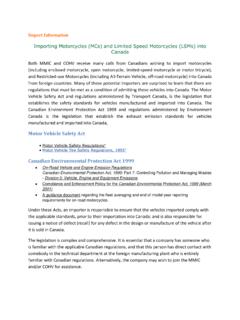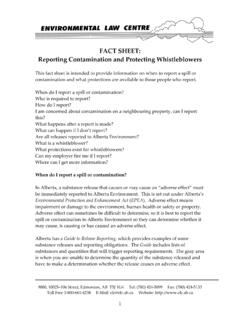Transcription of CANADIAN ENVIRONMENTAL PROTECTION ACT, 1999 …
1 ASSEMBLY OF FIRST NATIONS CANADIAN ENVIRONMENTAL PROTECTION ACT, 1999 (CEPA, 1999 ) TOOLKIT What is the CANADIAN ENVIRONMENTAL PROTECTION Act, 1999 ? What is the purpose of CEPA, 1999 ? The primary purpose of the CANADIAN ENVIRONMENTAL PROTECTION Act, 1999 as stated in the legislation is to contribute to sustainable development through pollution prevention . The full title of the Act, An Act respecting pollution prevention and the PROTECTION of the environment and human health in order to contribute to sustainable development , also helps to explain the purpose of the legislation. What does the legislation deal with? This Act covers a large variety of topics, including: pollution prevention; control of toxic substances; genetically modified living organisms; pollution and waste; ENVIRONMENTAL emergencies; government operations and ENVIRONMENTAL management on Federal and Aboriginal lands. However, the Act is limited in that most matters are dealt with by permits or the establishment of guidelines or codes of practice.
2 How does the Act help prevent pollution? The Act requires that no new substance such as chemicals or genetically modified living organisms may be introduced for sale in Canada before the government has determined if the product is toxic. If it is toxic, the government can impose conditions on the handling or use of the substance or even prohibit its importation or manufacture in Canada. How does the Act help control pollution and waste? The Act has many provisions dealing with controlling pollution and managing waste, including: PROTECTION of the marine environment from land-based sources of pollution; disposal at sea; fuels; vehicle, engine and equipment emissions; international air and water pollution; and the control of movement of hazardous waste What are the enforcement provisions of CEPA, 1999 ? The government has wide powers of enforcement under CEPA, 1999 . They may inspect and search buildings, detain ships, and impose fines and imprisonment.
3 The courts may impose fines of up to one million dollars and imprisonment for a term of up to three years. How can I find out more about CEPA, 1999 ? You can contact Environment Canada at: CEPA Registry Office 351 St. Joseph Boulevard, Gatineau, Quebec K1A 0H3 or by E-mail at: or you can find out more on-line at: ASSEMBLY OF FIRST NATIONS CANADIAN ENVIRONMENTAL PROTECTION ACT, 1999 (CEPA, 1999 ) TOOLKIT First Nations and the CANADIAN ENVIRONMENTAL PROTECTION Act, 1999 Does CEPA, 1999 apply to First Nations? Yes, the provisions of CEPA, 1999 apply to First Nations. As well, there are some provisions that apply only to First Nations or Aboriginal people. These include sections dealing with traditional knowledge, sentencing criteria, consultation, and ENVIRONMENTAL management on Aboriginal lands. Note that some provisions apply to Aboriginal people and others to Aboriginal Governments as defined under the Act. What are the provisions on traditional knowledge?
4 Under CEPA, 1999 the government has recognized the integral role of traditional aboriginal knowledge in the process of making decisions relating to the PROTECTION of the environment and human health. In the administration of the Act the government shall apply knowledge, including traditional aboriginal knowledge, science and technology to identify and resolve ENVIRONMENTAL problems . Review officers and members of boards of review must be knowledgeable about the CANADIAN environment, ENVIRONMENTAL and human health or traditional aboriginal ecological knowledge. How does the Act apply to Aboriginal lands? The federal government has the authority to manage Aboriginal lands under the Act. Aboriginal lands includes any lands subject to the Indian Act as well as lands subject to land claims or self-government agreements where title in the land is held by the federal Crown. More information on the application of the Act to Aboriginal lands is included below.
5 What are the Aboriginal sentencing criteria? In imposing a sentence under the Act, the court shall take into account the circumstances of Aboriginal offenders. What provisions are made for consultation with First Nations under CEPA, 1999 ? There are a number of places in the legislation where the Act specifically requires the federal government to give Aboriginal governments , and occasionally Aboriginal people, the opportunity to comment on particular issues. This includes for example, consultation on the development of guidelines and codes of practice with respect to pollution prevention, human health, or controlling toxic substances or making regulations with respect to fuels and ENVIRONMENTAL emergencies, among other things. More information on First Nations participation in the implementation of the Act is supplied below. ASSEMBLY OF FIRST NATIONS CANADIAN ENVIRONMENTAL PROTECTION ACT, 1999 (CEPA, 1999 ) TOOLKIT ENVIRONMENTAL PROTECTION on Aboriginal Lands What are Aboriginal Lands ?
6 Aboriginal lands are defined under CEPA, 1999 as any lands subject to the Indian Act as well as lands and waters subject to land claims or self-government agreements where title in the land is held by the federal Crown, and air and all layers of the atmosphere above and the subsurface below these lands and waters. Why are Aboriginal Lands covered by CEPA, 1999 ? The Federal Government continues to assume primary jurisdiction over ENVIRONMENTAL matters on Aboriginal lands, as it has not recognized the inherent rights of First Nations to be self-governing in this matter. The federal government took this authority to address what has been called a regulatory gap . What is the regulatory gap The federal, provincial and territorial governments have authority to manage various elements of the environment including water quality, air pollution, land use planning, commercial activities, etc. The provincial and territorial governments manage provincial and territorial lands and federal government manages federal lands, including Aboriginal lands.
7 The provincial and territorial governments, through their responsibility for local matters, have developed a host of environment related legislation and regulation to manage many ENVIRONMENTAL issues. As Aboriginal lands fall under the authority of the federal government, this provincial and territorial legislation and regulation does not apply on Aboriginal lands. The federal government has not adopted a similar body of legislation, however. For example, there is no federal legislation dealing with the control of emissions from industrial establishments that may be established on reserve. This lack of federal legislation with respect to ENVIRONMENTAL PROTECTION on Aboriginal lands is called the regulatory gap . What authority does the federal government have to address ENVIRONMENTAL matters on Aboriginal lands? Under Part 9 of CEPA, 1999 Environment Canada is required to establish objectives, guidelines, and codes of practice for the purpose of carrying out the Minister s duties and functions related to the quality of the environment with respect to Aboriginal lands.
8 In addition, the Minister may recommend that regulations be established to address a host of ENVIRONMENTAL and human health issues including, for example, establishment of ENVIRONMENTAL management systems, ENVIRONMENTAL emergencies, information about works and activities on Aboriginal lands , and the use, manufacture, release, or sale of substances on Aboriginal lands . Currently, there are no objectives, guidelines or codes of practice that have been established under this Part and there are only three regulations under Part 9. These are regulations on halocarbons, mobile PCB treatment and destruction, and registration of storage tank systems for petroleum products and allied petroleum products. ASSEMBLY OF FIRST NATIONS CANADIAN ENVIRONMENTAL PROTECTION ACT, 1999 (CEPA, 1999 ) TOOLKIT First Nations Participation in CEPA, 1999 How can First Nations participate in the implementation of CEPA, 1999 ? There are a number of ways that First Nations can participate including: participation of Aboriginal governments on the National Advisory Council (NAC); through consultation; and administration, equivalency or ENVIRONMENTAL monitoring agreements.
9 How are Aboriginal governments defined under the Act? The Act defines Aboriginal governments as including only those that have self-government agreements with the Government of Canada that address ENVIRONMENTAL PROTECTION , ( (1)). Currently this includes only the James Bay Cree, the Yukon First Nations, Nisga a, and the Inuit. To be clear, this does not include Band Councils. Bands that are party to the First Nations Land Management Act, however are considered Aboriginal governments for the purpose of this Act once they have signed ENVIRONMENTAL agreements. It may also include M tis governments at some point in time. The reason the definition is important for First Nations is that only Aboriginal governments are invited to participate on NAC and in some of the other decision making opportunities. What are the consultation provisions? The federal government is required to give Aboriginal governments , and occasionally Aboriginal people, the opportunity to comment on certain issues.
10 Please see above for more information. What are administration agreements? Administration Agreements would allow an Aboriginal government or Aboriginal people to administer parts of the Act. Note that both Aboriginal governments as defined under the Act, and Band Councils may enter into agreements with the Minister to take over administration of the Act. No such administration agreements have been entered into with First Nations at this time. What are equivalency agreements? Equivalency agreements establish that certain parts of the Act would not apply in a particular territory, province or on Aboriginal lands administered by an Aboriginal government . Agreement would be reached with the federal government that laws passed by these other jurisdictions are equal to the provisions under the Act. To date there are no such agreements entered into with Aboriginal governments . What are monitoring agreements? Part 3 of the Act allows the Minister to enter into agreements with Aboriginal people to operate or maintain ENVIRONMENTAL monitoring systems.



















